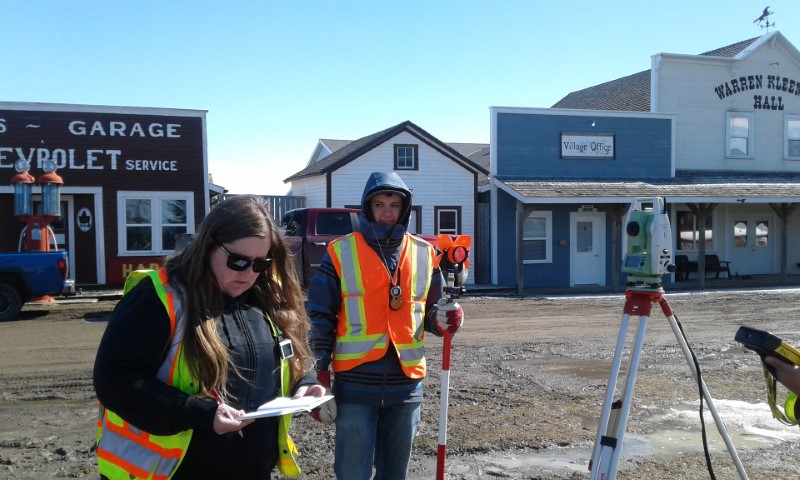Geomatics Engineering Technology students troubleshoot real-world challenges
A new partnership between Lethbridge College and the Prairie Tractor and Engine Museum Society gave Geomatics Engineering Technology students a true taste of surveying challenging terrain in winter conditions.
Bill Smienk, chair of the School of Engineering Technologies, says the college’s agreement with the society, signed earlier this year, saw students survey the Coyote Flats Pioneer Village property near Picture Butte. Aside from giving students practical and purposeful work for an actual client, the partnership has potential for future student efforts, including applied research.
“There’s potential there to help the society with its immediate needs, but there’s also potential to continue to be involved in other ways,” says Smienk. Aside from marking the bounds of the society’s property – the focus of this year’s work — college students could provide topographical data of elevation or draft detailed floor plans of the historic structures.

Pieter van Ewijk, general manager of the pioneer village, says the students’ efforts were important to the society, which operates entirely on grants and donations.
Located about 40 kilometres north of Lethbridge College, the historic village is home to more than 25 historic buildings and dozens of tractors from past decades.
The property includes a steep coulee slope, making for irregular boundaries. Van Ewijk says over the years, buildings have been added to the site in a rough grid pattern, but as the collection grows, a more detailed survey of the site, including the location of underground utilities, will help with planning.
Instructor Andrew Bowen and technologist Jim Pinches accompanied about 20 second-year students to the property twice in the weeks before and after Easter, where they experienced challenges that included unseasonable cold and snow.
The site work replaced a lab project that has students design an oil pipeline along the west and south edges of Lethbridge College campus. While that experience is also hands-on, there’s a different level of authenticity to the students’ work when they’re on someone else’s land and making measurements a group will actually use, Bowen says.
Bowen says students encountered challenges surveyors encounter in the field. Satellite coverage was lacking so they couldn’t use Global Positioning Systems (GPS) for location and measurements. Instead they used total stations, instruments using lasers and prisms to measure distances, and metal detectors to locate historic steel pegs, considered accurate reference points to confirm their own findings.
The outings in April gave students valuable experience in retracing boundaries of a property, troubleshooting and co-ordinating efforts among seven surveying teams, Bowen says.
“Only one student had seen the site once before,” he says. “No one knew what they were getting into. If I had a nickel for every site I’d seen before I had to survey it, I wouldn’t have any nickels. You roll up on site, you assess challenges and obstacles and that’s when you come up with your plan. You finalize your plan on the site.”
Ashley Burns, who convocated last month from the two-year Geomatics Engineering Technology program and will return this fall to study Civil Engineering, said she appreciated the opportunity to work off campus, as part of a team with fellow students.
“I hope we made him (Bowen) proud. He trusted us, our judgment and our capabilities.”
That approach to learning was noticed also by van Ewijk.
“I was really impressed with his method,” van Ewijk says of Bowen. “When students came to him with questions, he would often ask another question. ‘How will you solve this?’ Really, I think they’re being taught to think for themselves. It’s highly important, and the students were really into it.”
He also credited the students for their “very polite, very professional” approach.
Burns says the field trip also demonstrated how time consuming surveying can be to do it well.
“Everything seems simple on paper, but it doesn’t always work out like that.”
She hopes other students will have the chance to work at the site.
“It was a good learning experience for everyone. It was a huge privilege. I’m really glad we got to do something like that.”
Coyote Flats Historic Village opens for the season May 19 with an opening tea and quilt show. The tea runs from 2 to 4 p.m., May 19 in Kleeman Hall. Admission by donation. About 100 quilts will be on display from 10 a.m. to 5 p.m., May 19 to May 24. For more information on the historic village, please call (403) 732-5451.
Instructor Andrew Bowen speaks about the process, partnership and opportunities for students in the Coyote Flats project: